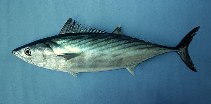Sarda chiliensis (Cuvier, 1832)
Eastern Pacific bonito
個人による観察記録の追加 Fish Watcher
| Native range | All suitable habitat | Point map | Year 2050 |

|
| This map was computer-generated and has not yet been reviewed. |
| Sarda chiliensis AquaMaps Data sources: GBIF OBIS |
Upload your 写真 and ビデオ
Pictures | Videos | Stamps, coins, misc. | グーグルの画像Sarda chiliensis
Picture by Béarez, P.
Pictures | Videos | Stamps, coins, misc. | グーグルの画像Sarda chiliensis
Picture by Béarez, P.
Chile country information
Common names:
Bonito
Occurrence: native
Salinity: marine
Abundance: | Ref:
Importance: minor commercial | Ref: Nakamura, I., T. Inada, M. Takeda and H. Hatanaka, 1986
Aquaculture: | Ref:
Regulations: | Ref:
Uses: no uses
Comments: Also Ref. 9068, 27363.
National Checklist:
Country Information: https://www.cia.gov/library/publications/resources/the-world-factbook/geos/ci.html
National Fisheries Authority:
Occurrences: Occurrences Point map
Main Ref: Collette, B.B. and C.E. Nauen, 1983
National Database:
Occurrence: native
Salinity: marine
Abundance: | Ref:
Importance: minor commercial | Ref: Nakamura, I., T. Inada, M. Takeda and H. Hatanaka, 1986
Aquaculture: | Ref:
Regulations: | Ref:
Uses: no uses
Comments: Also Ref. 9068, 27363.
National Checklist:
Country Information: https://www.cia.gov/library/publications/resources/the-world-factbook/geos/ci.html
National Fisheries Authority:
Occurrences: Occurrences Point map
Main Ref: Collette, B.B. and C.E. Nauen, 1983
National Database:
Common names from other countries
分類 / Names 共通名の | 類義語 | Catalog of Fishes(部類, 種) | ITIS | CoL | WoRMS | Cloffa
> Scombriformes (Mackerels) > Scombridae (Mackerels, tunas, bonitos) > Scombrinae
Etymology: Sarda: Latin and Greek, sarda = sardine; name related to the island of Sardinia (Ref. 45335); chiliensis: Named after Chile, South America (Ref. 6885).
More on author: Cuvier.
Etymology: Sarda: Latin and Greek, sarda = sardine; name related to the island of Sardinia (Ref. 45335); chiliensis: Named after Chile, South America (Ref. 6885).
More on author: Cuvier.
Issue
Issue on validity of subspecies: subspecies considered as valid in FB, elevated to species rank as Sarda chiliensis (Cuvier, 1832) in Eschmeyer (CofF ver. May 2011: Ref. 86870).
Environment: milieu / climate zone / depth range / distribution range 生態学
分布 国々 | 国連食糧農業機関の区域 | エコシステム | 事件 | Point map | 導入 | Faunafri
Southeast Pacific: northern Peru to Talcahuano, Chile (Ref. 9340). The northern subspecies Sarda chiliensis lineolata occurs from off the coast of Alaska, southward to Cabo San Lucas at the tip of Baja California, and in the Revillagigedo Islands.
Length at first maturity / サイズ / 重さ / 年齢
Maturity: Lm 47.0 range ? - ? cm
Max length : 102 cm TL オス/雌雄の選別がない; (Ref. 9015); 最大公表体重: 11.3 kg (Ref. 168)
Max length : 102 cm TL オス/雌雄の選別がない; (Ref. 9015); 最大公表体重: 11.3 kg (Ref. 168)
簡単な記述 検索表 | 形態学 | 形態計測学
背面の脊椎 (合計) : 17 - 19; 臀鰭: 12 - 15; 脊つい: 42 - 46. Mouth moderately large. Laminae of olfactory rosette 21 to 39. Interpelvic process small and bifid. Swim bladder absent. Spleen large and prominent in ventral view. Liver with elongate left and right lobes and a short middle lobe. Body completely covered with very small scales posterior to the corselet.
A coastal species that reaches sexual maturity at two years of age (Ref. 9340). Older individuals are encountered farther from the coast as compared to the juveniles (Ref. 9340). Spawning is discontinuous and a female of 3 kg may produce millions of eggs per season (Ref. 9340). Forms schools by size. Feeds on a variety of small schooling fishes, squids and shrimps. This species is important to the recreational hook and line fishery operating from private and party boats, piers and jetties, and from the shore. Also caught with encircling nets (Ref. 9340). Utilized fresh, canned and frozen; eaten broiled and baked (Ref. 9988).
Life cycle and mating behavior 成熟 | 繁殖 | 放精 | 卵 | 生産力 | 幼生
主な参考文献
Upload your references | 参考文献 | コーディネーター : Collette, Bruce B. | 協力者
Collette, B.B. and C.E. Nauen, 1983. FAO Species Catalogue. Vol. 2. Scombrids of the world. An annotated and illustrated catalogue of tunas, mackerels, bonitos and related species known to date. Rome: FAO. FAO Fish. Synop. 125(2):137 p. (Ref. 168)
人間に対する脅威
Harmless
Human uses
水産業: 高い商業の; ゲームフィッシュ: はい
FAO(水産業: 代謝, 種の外形; publication : search) | FishSource | 私達の周りの海
より多くの情報
Population dynamics
成長のパラメーター
Max. ages / sizes
Length-weight rel.
Length-length rel.
体長組成
Mass conversion
補充
豊度
成長のパラメーター
Max. ages / sizes
Length-weight rel.
Length-length rel.
体長組成
Mass conversion
補充
豊度
Anatomy
カマ
Brain
Otolith
カマ
Brain
Otolith
Physiology
Body composition
Nutrients
酸素消費
水泳形態
泳ぐ速さ
Visual pigments
Fish sound
Diseases & Parasites
Toxicity (LC50s)
Body composition
Nutrients
酸素消費
水泳形態
泳ぐ速さ
Visual pigments
Fish sound
Diseases & Parasites
Toxicity (LC50s)
Genetics
遺伝子の
Heterozygosity
遺伝
遺伝子の
Heterozygosity
遺伝
用具
E-book | 野外観察図鑑 | Length-frequency wizard | 生活史の基盤ツール | 目的のマップ | Classification Tree
| Catch-MSY |
特記事項
XMLをダウンロードして下さい
インターネットの情報源
Aquatic Commons | BHL | Cloffa | Websites from users | Check FishWatcher | CISTI | Catalog of Fishes(部類, 種) | DiscoverLife | ECOTOX | Faunafri | Fishtrace | GenBank(ゲノム, ヌクレオチド) | GloBI | GOBASE | | Google Books | Google Scholar | Google | IGFA World Record | MitoFish | Otolith Atlas of Taiwan Fishes | PubMed | Reef Life Survey | RFE Identification | Scirus | SeaLifeBase | 生命の木 | Wikipedia(行く, 検索する) | World Records Freshwater Fishing | 動物に関する記録
Estimates based on models
Preferred temperature (Ref. 115969): 14.6 - 23.1, mean 18.5 (based on 30 cells).
Phylogenetic diversity index (Ref. 82804): PD50 = 0.5312 [Uniqueness, from 0.5 = low to 2.0 = high].
Bayesian length-weight: a=0.00955 (0.00838 - 0.01089), b=3.06 (3.02 - 3.10), in cm Total Length, based on LWR estimates for this species (Ref. 93245).
栄養段階 (Ref. 69278): 4.5 ±0.3 se; based on diet studies.
回復力 (Ref. 120179): 手段, 1.4年~4.4年の倍増期間の最小個体群 (K=0.15; tm=2).
Prior r = 0.51, 95% CL = 0.33 - 0.76, Based on 1 data-limited stock assessment.
Fishing Vulnerability (Ref. 59153): Moderate vulnerability (36 of 100).
Climate Vulnerability (Ref. 125649): High to very high vulnerability (71 of 100).




